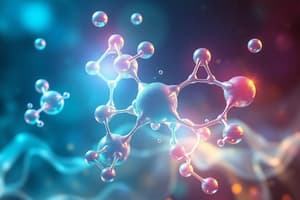Podcast
Questions and Answers
Qual es le definition del 'massa atomica'?
Qual es le definition del 'massa atomica'?
- Le massa de un molecula in relation al numero de Avogadro.
- Le massa de un isotopo comparate a un elemento pure.
- Le summa de masses de todos le atomos in un molecula.
- Le massa de un atom, expressate in unidades de massa atomica. (correct)
Como se define un 'mole' in chimica?
Como se define un 'mole' in chimica?
- Un numero exact de 12 grammas de carbone.
- Le massa de un molecula in unitates de massa atomica.
- Un quantitate de substancia que contine un isotopo specific.
- Un quantitate de materia con le massa moleculare de 6.022 x 10^23 particulas. (correct)
Qual es le diferente inter 'massa empirica' e 'massa molecular'?
Qual es le diferente inter 'massa empirica' e 'massa molecular'?
- Massa empirica se basa super factores de conversion, massa molecular non.
- Massa molecular es le summa exacte del masses de atomos in un molecula, massa empirica es un ratio. (correct)
- Massa empirica se refere a un numero exact, massa molecular es un medio.
- Massa empirica es sempre un numero inteiro, massa molecular non.
Initialmente, quales atomos pote formar un 'compound'?
Initialmente, quales atomos pote formar un 'compound'?
Le 'numero de Avogadro' es typicmente usate pro calcular qué?
Le 'numero de Avogadro' es typicmente usate pro calcular qué?
Flashcards
Atom
Atom
Le plus petite unite de un elemento chimic.
Molecule
Molecule
Un groupe de atomes ligate.
Mole
Mole
Un unite de mesure de la quantite de substance.
Atomic Mass
Atomic Mass
Signup and view all the flashcards
Avogadro's number
Avogadro's number
Signup and view all the flashcards
Study Notes
Atom
- An atom is the fundamental building block of matter.
- It consists of a nucleus containing protons and neutrons, with electrons orbiting the nucleus.
- Atoms are electrically neutral, with an equal number of protons and electrons.
- Atoms of the same element have the same number of protons.
Atomic Mass
- Atomic mass is the weighted average mass of all the naturally occurring isotopes of an element.
- It is expressed in atomic mass units (amu).
- Atomic mass is not the same as mass number (the sum of protons and neutrons).
Molecule
- A molecule is a group of two or more atoms held together by chemical bonds.
- Molecules can be composed of the same element (e.g., O2) or different elements (e.g., H2O).
- Molecules possess unique properties that differ from their constituent atoms.
Compound
- A compound is a substance formed when two or more different elements are chemically bonded together in a fixed ratio.
- Compounds have unique properties different from the elements they are composed of.
- Compounds can be broken down into simpler substances (elements) by chemical means.
Magnitude
- Magnitude refers to the relative size or scale of a value or quantity.
- In chemistry, magnitude can describe the size/ scale of atomic or molecular properties like mass.
- Understanding magnitude helps in appreciating the relative importance of a certain value, like when calculating the ratio between elements.
Molar Mass
- Molar mass is the mass of one mole of a substance.
- It is expressed in grams per mole (g/mol).
- Molar mass is numerically equal to the atomic mass or formula mass in g/mol.
Isotopes
- Isotopes are atoms of the same element with the same number of protons but different numbers of neutrons.
- Isotopes have the same chemical properties but different physical properties, such as mass.
- The relative abundance of isotopes affects the atomic mass of an element.
Mole
- A mole (mol) is a unit of measurement representing a specific number of entities (atoms, molecules, ions).
- One mole of a substance contains Avogadro's number of entities.
- Moles are used to relate the mass of a substance to the number of particles it contains.
Avogadro's Number
- Avogadro's number is approximately 6.022 x 1023 .
- It represents the number of entities in one mole of a substance.
- Avogadro's number is crucial for converting between moles and numbers of particles.
Empirical Mass and Molecular Mass Conversion
- Empirical formula represents the simplest whole number ratio of atoms in a compound.
- Molecular formula shows the exact number of atoms of each element in a molecule.
- The conversion between empirical and molecular formulas involves comparing their respective molar masses.
- By dividing the molecular mass by the empirical mass, we determine a factor used to derive the molecular formula.
Studying That Suits You
Use AI to generate personalized quizzes and flashcards to suit your learning preferences.




